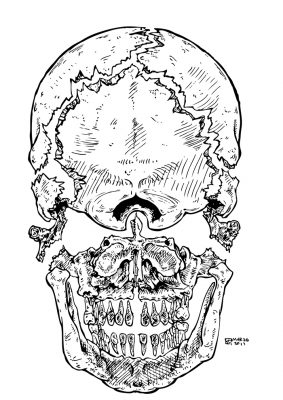
By Lana Sweeten-Shults
GCU News Bureau
The morning sun has barely poked its rays over Camelback Mountain and, already, the chatter volume is high in the Building 57 anatomy lab.
More than a dozen students have plopped their backpacks down and have delved into different projects in one of the most bustling laboratories on the Grand Canyon University campus, one that 200 to 300 students pass through every week.

This morning, the room – aglow in fluorescent lighting and wafting with the smell of formaldehyde – is jam packed with student researchers who are part of the Research and Design Program’s Anatomical Atlas Project.
It’s a massive undertaking that involves an estimated 70 students creating their own encyclopedia of the human body and using cadavers from GCU’s cadaver lab to do so – the school usually touts 18 cadavers per semester acquired through the National Body Donor Program in St. Louis. The student-generated book will be a human cadaveric photographic atlas, or map, of the human body, complete with cadaver dissections, student-produced artwork, photographs, histology, clinical pathology cases, accompanying text and the like.
Work began on the project about a year ago, said Michael Bodeen, the College of Science, Engineering and Technology’s lead instructor for human dissection and the faculty member who oversees the anatomy lab.
An anatomy atlas isn’t new. Anyone who has taken an anatomy class or biology class has likely flipped through the pages of Netter’s Anatomy Coloring Book or Netter’s Clinical Anatomy.
But what is new is getting students to author their own version of such an atlas – they’ll be credited as the authors, Bodeen emphasized. The faculty involved in the project -- Bodeen in addition to Sandy Bledsoe, Will Primack, David Jackson and Ryan Cannon -- are simply the mentors.
“We’ll have our own personal GCU book,” said junior biochemical, medical and biology major Alejandro Perez, one of the student researchers. “We get to put in facts we really want, because there are plenty of books out there but they don’t always put in the information that we want. Hopefully we’ll get to make a fantastic book.”
Just call it hands-on teaching 2.0.
“This is phenomenal text for kids to learn from. So here’s the brain and they’ll have all the information here,” said Bodeen, pointing to a copy of Netter’s Clinical Anatomy, then adding, excitedly, “We can produce this. Students can make something like this following that example.”

To produce such an involved reference work, the Anatomy RDP Group is tackling the project by dividing student researchers into special teams– photography, radiology, dissection, clinical skills, 3D printing, pathology and histology, to name a few.
Junior premed biology student Jonathan Kertich is one of the team’s dissectors. They are in charge of dissecting cadavers and preparing them so certain structures in the body will be visible.
“They (the dissectors) have to prepare the cadavers like what needs to be shown in the atlas,” said Kertich, who not only dissects cadavers but also mentors fellow students. Working so much with the cadavers, he gets to know the parts of the body well.
Becoming a dissector isn’t something an Anatomical Atlas Project member begins without some preparation.
“We kind of start them off in kind of a helical development,” Bodeen said. “We gently bring them in, have them learn the bones. They have to take a test on bones, then we roll them over to special dissection.”
Bodeen said since Anatomy RDP members’ interests, majors and specializations are different, he tries to make sure to assign a student a special project that will advance their studies. “For example, if you want to be a cardiac surgeon, well, I’m going to put you on a special project on the heart.”
Kertich added, “When a student joins, they don’t go straight to dissection of the cadaver. To give them a basic understanding of how concrete the program is going to be, how hard it’s going to be, if they want to go into the program, they start with special projects."
They might be assigned to learn everything they can about the liver, for example. Once they’ve mastered their special project and taken their muscles and bones test, they’re ready to start dissections under the guise of a mentor, such as Kertich.

“If the student proves themselves, meaning if they’re doing the reading, it will be evident," Bodeen said. "I’ll be talking to them about the anatomy of what they just dissected. If they can demonstrate that they are knowledgeable, they will then be elevated. You earn your place, basically. Once a place opens up in the cadaver, then we’ll give you that.”
Kertich said, “Once the dissectors have prepared the cadavers, the photography group will then take the photographs and digitally clean them. The photographs are then submitted to students in the editing group, who are charged with formatting and the overall content of the atlas. A histology group takes pictures using a digital microscope and also submits their work. There’s another group, the logistics group. They have to check the progress of each and every group. Logistics is going to assess and see, ‘Oh, you’re 50 percent done with your project. You should be at 75 percent by this time of the semester.'”
Senior premed major Courtney Nelson has been a part of the Anatomy RDP Group for a year.
“I actually just got assigned to be the table lead for Table 2, and what that means is I keep track of everyone’s hours that’s working on a table so I can make sure everyone is putting in the equal amount of effort and pulling their own weight because there is a lot of work that has gone into, and is still going into, the creation of the atlas,” she said.
Other students tackle jobs for the project that seem to have little to do with anatomy.
“Our artists are phenomenal, they draw really well. You should see some of their artwork. It just blows my mind,” Bodeen said. “The artists, some of them are premed, some of them are bioengineering. They just love art.”
What Bodeen loves about this project is that it’s not the typical sit-at-your-desk-and-listen-to-a-lecture format. He is working on a paper about educational experiences that lift up the student, and this fits that mold.
“It’s a little different kind of form of education than what we typically have, sitting in a classroom, going to a lab and checking boxes,” he said. “I’d like to do a compare and contrast between students and see how well they do in maybe getting into graduate school vs. people who don’t participate with that (in the Anatomical Atlas RDP). That’s not clearly worked out yet. It’s in motion. But I’ll map it out as I go and say, hey, we’ve got a different method providing an educational experience vs. just sitting in the classroom forever.”

Bodeen said the atlas will be completed digitally and edited for mistakes before a first edition is completed. After that will come a second edition, with more editing, “that will be ready for prime time.”
“The quality has to be there first,” Bodeen said. “We’re shooting for quality and excellence. Obviously, it’s not usable if there’s tons of mistakes.”
He’s hoping to have that digital edition completed by the end of the year.
Another boon with this project, Bodeen said, is that students are not only getting hands-on education but graduate-level education, too. It’s rare that undergraduate students get the chance to work on cadavers – something that’s usually reserved for graduate students. The project focuses on anatomy “above and beyond what’s taught in the classroom,” he said, and it better prepares students for graduate-level courses.
“It’s going to give us a real foundation for medical school. You learn a lot from being in here. It’s kind of like a ramp – the projection is very high,” Kertich said of the learning curve.
Nelson joined the Anatomy RDP Group, she said, because “it gives me a really great experience to be able to learn with such a unique, hands-on opportunity like this.”
Perez said he fell into the Anatomy RDP Group through friends who suggested he join. Not only has he learned graduate-level anatomy; he also has come to respect the bodies that get donated to GCU so students can learn.
Ask him if he thinks the Anatomy RDP Group elevates students’ knowledge of anatomy that much. He says, immediately, “One hundred percent. It’s not for everyone, but if anyone’s willing to put in the time and effort …
"I’m one of those people who didn’t pick it up right away, but I kept coming and they kept testing me, and eventually I understood it.”
He added, “It’s amazing, because I don’t know any other school that allows you to take charge. We’re not just students here. We’re expected to be more than just students.”
You can reach GCU senior writer Lana Sweeten-Shults at 602-639-7901 or by email at [email protected]. Follow her on Twitter @LanaSweetenShul.















